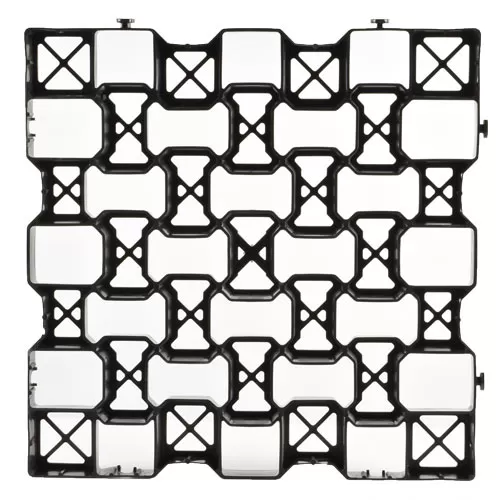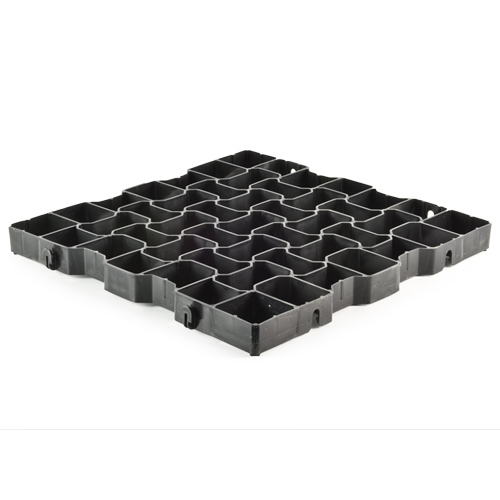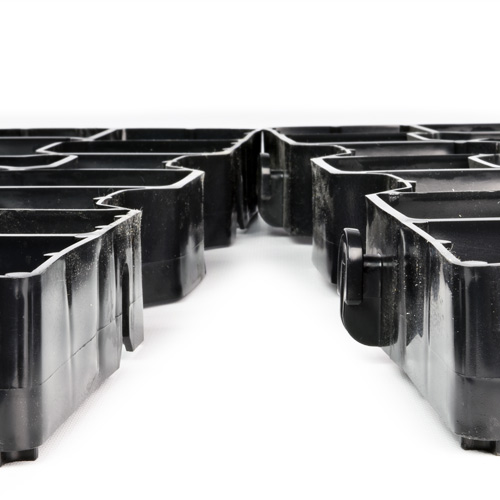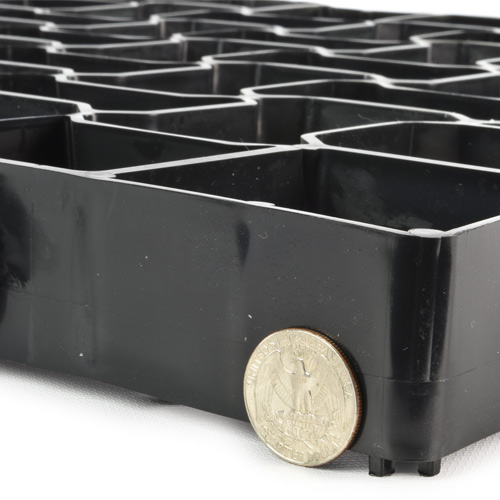What Is a Soil Stabilization Grid?
Related Product: GeoGrid Cellular Paving System 4 cm x 1.6x1.6 Ft.
After laying out the geogrid tiles, the installer may apply granular material over the top of the soil stabilization grid product, such as gravel or rock. The rocks penetrate through each cell in the permeable grid and interlock with the soil underneath.
 A product like the GeoGrid Cellular Paving System uses a 100% recycled or virgin high density polyethylene (HDPE) plastic in a geogrid pattern. It works like a gravel holder, increasing the ability of the soil to bear heavy loads and to resist erosion issues.
A product like the GeoGrid Cellular Paving System uses a 100% recycled or virgin high density polyethylene (HDPE) plastic in a geogrid pattern. It works like a gravel holder, increasing the ability of the soil to bear heavy loads and to resist erosion issues.
Even at only 4 cm in thickness (about 1.5 inches), the plastic is extremely durable, able to hold up to the stress of heavy equipment. Once installed properly, the entire grid or an individual tile can support up to 35 tons per square foot on the surface.
What Are Some Uses for a Soil Stabilization Grid?
For a customer looking to buy this product, some of the most common use cases for installing soil stabilization grid tiles include the following.Temporary Driveway or Parking
At a construction site or at a building site for a home where trucks and equipment need to reach a remote area, these tiles can work to shore up rough areas where the driveway could crumble under constant traffic.
These tiles work nicely in an area where gravel alone won’t guarantee that the soil underneath the gravel will continue to hold together. When the driveway will need to be in place for several weeks, months or years, this material gives it the stability it needs.
Adding a permanent area for overflow parking is another common use for a soil stabilization grid. Overflow parking sometimes involves an open field or a dirt area that may not stand up to heavy traffic. Using these grids can ensure the area will remain stabilized and is always ready for overflow parking.
Patio or Seating Area
Some properties don’t have a natural sitting patio area for outdoor gatherings. If the property has a beautiful scenic overlook, though, you may want to create a place to sit and enjoy the view.
If you’re worried about the area dangerously crumbling away as people walk toward the overlook or as people are using the area, these soil stabilization grid tiles can keep the area maintained, no matter how often people use it and walk on the soil.
With these grids, installers can place sand and gravel inside the cells to hold the integrity of the area for a walking path. Another option is to add decorative stones in the area over the top of the grid tiles, which can be a great look for a patio.
They even work great under patio pavers to allow for drainage.
As a final option, installers can place soil in the cells and overseed the area with grass, allowing grasses and plants to grow over the top, maintaining a natural look in the area.
Walking Path
In parks or trail areas, washouts can occur from repeated rain, creating an unsafe surface for walkers, bikers, and hikers. With this grid material in place, it will keep the soil in place, resisting the erosion from washouts.
These tiles will work individually to protect a small space or will connect together to handle a larger space. Because the individual tiles are lightweight, weighing only 2.4 pounds apiece, it’s easy to carry them to a remote location on a hiking trail for installation.
Entrance Areas
As people walk through a gate on a property or at a trailhead, this area can become worn down with the repeated foot traffic. This creates low spots where rain collects, worsening the problem over time.
With the grid installed, the soil and gravel in these entrance areas will not wear away, as the cells in the grid will hold the soil in place. This preserves this area, allowing those entering through the gate or onto the trailhead to avoid stepping in puddles.
How Do You Install GeoGrid Soil Tiles?
Each GeoGrid tile measures about 1.62 feet across. It has interlocking tabs that allow an installer to connect the tiles to each other, creating stability in the area of the tiles and generating reinforcement for the area that’s subject to possible erosion and soil wear.These tiles ship on pallets, and they come in pre-connected sections of four tiles that will cover about 11 square feet apiece. If creating a temporary driveway or a patio area that will need large sections of these tiles, leave the sections connected as they come off the pallet to greatly reduce the time needed for the installation.
Installers can place these tiles over the top of a compacted surface, although an installation over the top of non-disturbed earth works too. Just fill the cells with soil or rock to complete the install.


